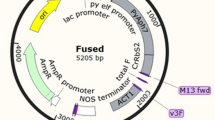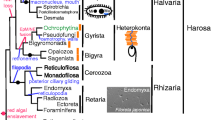Abstract
Gas vesicle formation and buoyancy regulation in Pelodictyon phaeoclathratiforme strain BU1 (Green sulfur bacteria) was investigated under various laboratory conditions. Cells formed gas vesicles exclusively at light intensities below 5 μmol · m-2 · s-1 in the stationary phase. No effect of incubation temperature or nutrient limitation was observed. Gas space of gas vesicles occupied always less than 1.2% of the total cell volume. A maximum cell turgor pressure of 330 kPa was determined which is comparable to values determined for cyanobacterial species. Since a pressure of at least 485 kPa was required to collapse the weakest gas vesicles in Pelodictyon phaeoclathratiforme, short-term regulation of cell density by the turgor pressure mechanism can be excluded.
Instead, regulation of the cell density is accomplished by the cease of gas vacuole production and accumulation of carbohydrate at high light intensity. The carbohydrate content of exponentially growing cells increased with light intensity, reaching a maximum of 35% of dry cell mass above 10 μmol · m-2 · s-1. Density of the cells increased concomitantly. At maximum density, protein and carbohydrate together accounted for 62% of the total cell ballast. Cells harvested in the stationary phase had a significantly lower carbohydrate content (8–12% of the dry cell mass) and cell density (1010–1014 kg · m-3 with gas vesicles collapsed) which in this case was independent of light intensity. Due to the presence of gas vesicles in these cultures, the density of cells reached a minimum value of 998.5 kg · m-3 at 0.5 μmol · m-2 · s-1.
The cell volume during the stationary phase was three times higher than during exponential growth, leading to considerable changes in the buoyancy of Pelodictyon phaeoclathratiforme. Microscopic observations indicate that extracellular slime layers may contribute to these variations of cell volume.
Similar content being viewed by others
References
Bührer H, Ambühl H (1975) Einleitung von Abwasser in Seen. Schweiz Z Hydrol 37: 347–369
Clark AE, Walsby AE (1978a) The occurrence of gas-vacuolate bacteria in lakes. Arch Microbiol 118: 223–228
Clark AE, Walsby AE (1978b) The development and vertical distribution of populations of gas-vacuolate bacteria in a eutrophic, monomictic lake. Arch Microbiol 118: 229–233
Cohen-Bazire G, Kunisawa R, Pfennig N (1969) Comparative study of the structure of gas vacuoles. J Bacteriol 100: 1049–1061
Dudman WF (1977) The role of surface polysaccharides in natural environments. In: Sutherland I (ed) Surface carbohydrates of the prokaryotic cell. Academic Press, London New York San Francisco, pp 357–414
Eichler B, Pfennig N (1986) Characterization of a new plateletforming purple sulfur bacterium Amoebobacter pedioformis sp. nov. Arch Microbiol 146: 295–300
Hartree EF (1972) Determination of protein: a modification of the Lowry-method that gives a linear photometric response. Anal Biochem 48: 422–427
Herbert D, Phipps PJ, Strange RE (1971) Chemical analysis of microbial cells. In: Norris J, Ribbons DW (eds) Methods in microbiology, vol. 5B. Academic Press, London, pp 209–344
Hutchinson GE (1967) A treatise on limnology, vol II. John Wiley, New York London Sydney
Irgens RL, Suzuki I, Staley JT (1989) Gas vacuolate bacteria obtained from marine waters of Antarctica. Curr Microbiol 18: 261–265
Konopka A, Brock TD, Walsby AE (1978) Buoyancy regulation by planktonic blue-green algae in Lake Mendota, Wisconsin. Arch Hydrobiol 83: 524–537
Kromkamp JC, Mur LR (1984) Buoyant density changes in the cyanobacterium Microcystis aeruginosa due to changes in the cellular carbohydrate content. FEMS Microbiol Lett 25: 105–109
Littlewood D, Postgate JR (1957) On the osmotic behaviour of Desulphovibrio desulphuricans. J Gen Microbiol 16: 596–603
Montesinos E, Guerrero R, Abella C, Esteve I (1983) Ecology and the competition for light between Chlorobium limicola and Chlorobium phaeobacteroides in natural habitats. Appl Environ Microbiol 46: 1007–1016
Oliver RL, Kinnear AJ, Ganf GG (1981) Measurement of cell density of three freshwater phytoplankters by density gradient centrifugation. Limnol Oceanogr 26: 285–294
Oliver RL, Walsby AE (1984) Direct evidence for the role of lightmediated gas vesicle collapse in the buoyancy regulation of Anabaena flos-aquae (cyanobacteria). Limnol Oceanogr 29: 879–886
Overmann J, Pfennig N (1989) Pelodictyon phaeoclathratiforme sp. nov., a new brown-colored member of the Chlorobiaceae forming net-like colonies. Arch Microbiol 152: 401–406
Overmann J, Tilzer MM (1989) Control of primary productivity and the significance of photosynthetic bacteria in a meromictic kettle lake, Mittlerer Buchensee, West-Germany. Aquatic Sci 51: 261–278
Pfennig N, Cohen-Bazire G (1967) Some properties of the green bacterium Pelodictyon clathratiforme. Arch Mikrobiol 59: 226–236
Pfennig N, Wagener S (1986) An improved method of preparing wet mounts for photomicrographs of microorganisms. J Microbiol Methods 4: 303–306
Pfennig N, Trüper HG (1989) Anoxygenic phototrophic bacteria. In: Staley JT, Bryant MP, Pfennig N, Holt JG (eds) Bergey's manual of systematic bacteriology, vol. 3. Williams and Wilkins, Baltimore, pp 1635–1709
Staley JT, Irgens RL, Herwig RP (1989) Gas vacuolate bacteria from the sea ice of Antarctica. Appl Environ Microbiol 55: 1033–1036
Thomas RH, Walsby AE (1985) Buoyancy regulation in a strain of Microcystis. J Gen Microbiol 131: 799–809
Utkilen HC, Skulberg OM, Walsby AE (1985) Buoyancy regulation and chromatic adaptation in planktonic Oscillatoria species: alternative strategies for optimizing light absorption in stratified lakes. Arch Hydrobiol 104: 407–417
VanLiere E, Walsby AE (1982) Interactions of cyanobacteria with light. In: Carr NG, Whitton BA (eds) The biology of cyanobacteria. Blackwell Scientific Publications, Oxford, pp 9–45
Walsby AE (1971) The pressure relationships of gas vacuoles. Proc R Soc Lond [Biol] 178: 301–326
Walsby AE (1972) Structure and function of gas vacuoles. Bacteriol Rev 36: 1–32
Walsby AE (1973) A portable apparatus for measuring relative gas vacuolation, the strength of gas vacuoles and turgor pressure in planktonic blue-green algae and bacteria. Limnol Oceanogr 18: 653–658
Walsby AE (1978) The properties and buoyancy-providing role of gas vacuoles in Trichodesmium Ehrenberg. Br Phycol J 13: 103–116
Walsby AE (1980) The water relations of gas-vacuolated prokaryotes. Proc R Soc Lond [Biol] 208: 73–102
Walsby AE (1981a) Gas-vacuolate bacteria. In: Starr MP, Stolp H, Trüper HG, Balows A, Schlegel HG (eds) The prokaryotes. A handbook on habitats, isolation and identification of bacteria. Springer, Berlin Heidelberg New York, pp 441–447
Walsby AE (1981b) Cyanobacteria: planktonic gas-vacuolate forms. In: Starr MP, Stolp H, Trüper HG, Balows A, Schlegel HG (eds) The prokaryotes. A handbook on habitats, isolation and identification of bacteria. Springer, Berlin Heidelberg New York, pp 224–235
Walsby AE (1982) The elastic compressibility of gas vesicles. Proc R Soc Lond [Biol] 216: 355–368
Walsby AE, Klemer A (1974) The role of gas vacuoles in the microstratification of a population of Oscillatoria agardhii var. isothrix in Deming Lake, Minnesota. Arch Hydrobiol 74: 375–392
Walsby AE, Kinsman R, Ibelings BW, Reynolds CS (1991) Highly buoyant colonies of the cyanobacterium Anabaena lemmermannii from persistent surface waterblooms. Arch Hydrobiol 121: 261–280
Author information
Authors and Affiliations
Rights and permissions
About this article
Cite this article
Overmann, J., Lehmann, S. & Pfennig, N. Gas vesicle formation and buoyancy regulation in Pelodictyon phaeoclathratiforme (Green sulfur bacteria). Arch. Microbiol. 157, 29–37 (1991). https://doi.org/10.1007/BF00245331
Received:
Accepted:
Issue Date:
DOI: https://doi.org/10.1007/BF00245331




